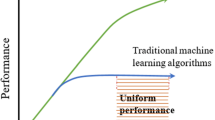Abstract
Artificial intelligence in medicine can help improve the accuracy and efficiency of diagnostics, selection of therapies and prediction of outcomes. Machine learning describes a subset of artificial intelligence that utilizes algorithms that can learn modeling functions from datasets. More complex algorithms, or deep learning, can similarly learn modeling functions for a variety of tasks leveraging massive complex datasets. The aggregation of artificial intelligence tools has the potential to improve many facets of health care delivery, from mundane tasks such as scheduling appointments to more complex functions such as enterprise management modeling and in-suite procedural assistance. Within radiology, the roles and use cases for artificial intelligence (inclusive of machine learning and deep learning) continue to evolve. Significant resources have been devoted to diagnostic radiology tasks via national radiology societies, academic medical centers and hundreds of commercial entities. Despite the widespread interest in artificial intelligence radiology solutions, there remains a lack of applications and discussion for use cases in interventional radiology (IR). Even more relevant to this audience, specific technologies tailored to the pediatric IR space are lacking. In this review, we describe artificial intelligence technologies that have been developed within the IR suite, as well as some future work, with a focus on artificial intelligence’s potential impact in pediatric interventional medicine.
Similar content being viewed by others
References
Tompkins HE (1963) A survey of computer achievements in life sciences and medicine. Proc IEEE 51:513–513
Shah NA, Hawkins CM (2015) Decreasing outpatient pre-procedure wait times in a pediatric interventional radiology (IR) department: a software-solution enabled quality improvement project. https://www.rsna.org/uploadedfiles/rsna/content/science/quality/storyboards/2015/shah_qs101.pdf. Accessed 4 Feb 2021
Perez S (2019) Google launches CallJoy, a virtual customer service phone agent for small businesses. TechCrunch. https://techcrunch.com/2019/05/01/google-launches-calljoy-a-virtual-customer-service-phone-agent-for-small-businesses/. Accessed 29 Sep 2020
No authors listed (2019) Philips showcases unique augmented reality concept for image-guided minimally invasive therapies developed with Microsoft. Philips News Center. https://www.usa.philips.com/a-w/about/news/archive/standard/news/press/2019/20190224-philips-showcases-unique-augmented-reality-concept-for-image-guided-minimally-invasive-therapies-developed-with-microsoft.htmld-with-microsoft.html. Accessed 4 Feb 2021
Putic G (2015) Advanced technology changing aircraft cockpits. Voa News. https://www.voanews.com/silicon-valley-technology/advanced-technology-changing-aircraft-cockpits. Accessed 4 Feb 2021
Letzen B, Wang CJ, Chapiro J (2019) The role of artificial intelligence in interventional oncology: a primer. J Vasc Interv Radiol 30:38–41 e1
Zimmermann JM, Vicentini L, Van Story D et al (2020) Quantification of avoidable radiation exposure in interventional fluoroscopy with eye tracking technology. Investig Radiol 55:457–462
Bang JY, Hough M, Hawes RH, Varadarajulu S (2020) Use of artificial intelligence to reduce radiation exposure at fluoroscopy-guided endoscopic procedures. Am J Gastroenterol 115:555–561
Abajian A, Murali N, Savic LJ et al (2018) Predicting treatment response to intra-arterial therapies for hepatocellular carcinoma with the use of supervised machine learning — an artificial intelligence concept. J Vasc Interv Radiol 29:850–857 e1
Seals K, Al-Hakim R, Mulligan P et al (2019) The development of a machine learning smart speaker application for device sizing in interventional radiology. In: Proceedings of the SIR Annual Scientific Meeting, Dallas. https://www.iotworldtoday.com/files/2019/10/IHSMarkit-IoT-Device-Smart-Speaker-1.pdf
Montany B (2018) More than 900,000 smart speakers to be used in healthcare facilities by 2021. News Tercera Edad. https://www.news3edad.com/2018/04/27/more-than-900000-smart-speakers-to-be-used-in-healthcare-facilities-by-2021/. Accessed 4 Feb 2021
Baum RA, Baum S (2014) Interventional radiology: a half century of innovation. Radiology 273:S75–S91
Behr T, Pusch TP, Siegfarth M et al (2019) Deep reinforcement learning for the navigation of neurovascular catheters. Curr Dir Biomed Eng 5:5–8
Jonsson A (2019) Deep reinforcement learning in medicine. Kidney Dis 5:18–22
Heran MKS, Burrill J (2012) Vascular pediatric interventional radiology. Can Assoc Radiol J 63:S59–S73
Mewes A, Hensen B, Wacker F, Hansen C (2017) Touchless interaction with software in interventional radiology and surgery: a systematic literature review. Int J Comput Assist Radiol Surg 12:291–305
Bigdelou A, Schwarz L, Navab N (2012) An adaptive solution for intra-operative gesture-based human-machine interaction. In: Proceedings of the 2012 ACM International Conference on Intelligent User Interfaces (IUI ’12). ACM Press, Lisbon, p 75
Lee A, Cho Y, Jin S, Kim N (2020) Enhancement of surgical hand gesture recognition using a capsule network for a contactless interface in the operating room. Comput Methods Prog Biomed 190:105385
Scavazzin M, Valentini F, Radoux J-P et al (2018) Conception of a touchless human machine interaction system for operating rooms using deep learning. In: Schelkens P, Ebrahimi T, Cristóbal G (eds) Optics, photonics, and digital technologies for imaging applications V. SPIE, Strasbourg, p 80
Bundy JJ, Hage AN, Srinivasa RN et al (2020) Burnout among interventional radiologists. J Vasc Interv Radiol 31:607–613 e1
Meek RD, Lungren MP, Gichoya JW (2019) Machine learning for the interventional radiologist. AJR Am J Roentgenol 213:782–784
Taylor AG (2020) Artificial intelligence in IR — here comes the heavy lifting. J Vasc Interv Radiol 31:1025–1026
Author information
Authors and Affiliations
Corresponding author
Ethics declarations
Conflicts of interest
Dr. Matthew P. Lungren is an adviser shareholder in Nines Radiology, Seg Med and Bunker Hill; receives research support from Google, Bayer, Philips, GE and Carestream; and has received an award from the National Institutes of Health.
Additional information
Publisher’s note
Springer Nature remains neutral with regard to jurisdictional claims in published maps and institutional affiliations.
Rights and permissions
About this article
Cite this article
Desai, S.B., Pareek, A. & Lungren, M.P. Current and emerging artificial intelligence applications for pediatric interventional radiology. Pediatr Radiol 52, 2173–2177 (2022). https://doi.org/10.1007/s00247-021-05013-y
Received:
Revised:
Accepted:
Published:
Issue Date:
DOI: https://doi.org/10.1007/s00247-021-05013-y




